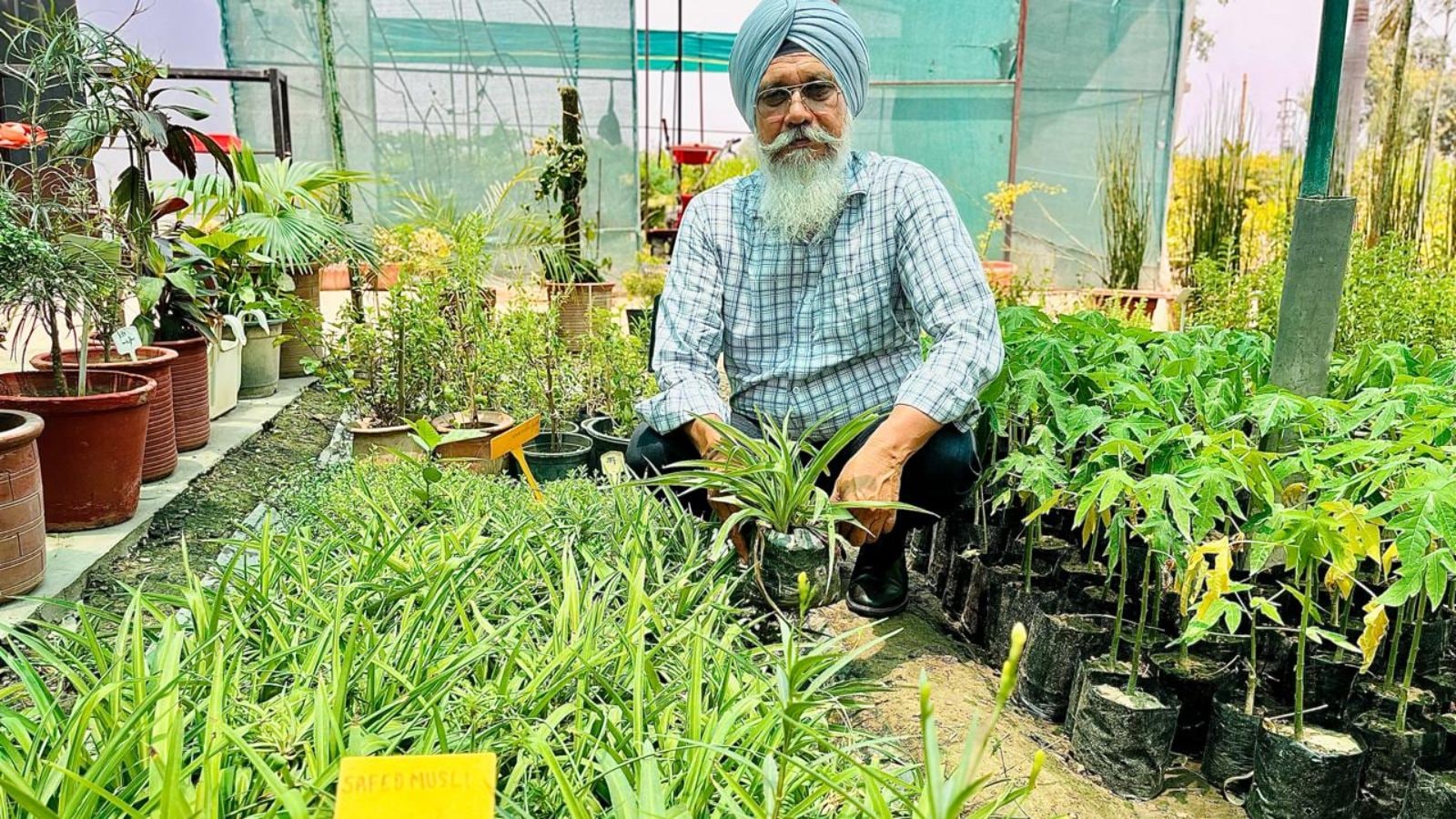For 66-year-old Joga Singh, a retired agriculture teacher, plants and natural healing has always been a calling and it was not surprising when he took to it completely after retirement.
Nestled in Sangala village of Punjab’s Malerkotla, Joga Singh has been growing a garden of medicinal transformation.
At his nursery ‘Nature View Nursery’ master Singh as people fondly call him, is cultivating an impressive array of aromatic spices and medicinal plants, many of which are rarely grown in Punjab. These include spices and herbs with both culinary and therapeutic value: chhoti ilaychi (green cardamom), badi ilaychi (black cardamom), dalchini (cinnamon), hing (asafoetida), karhi patta (curry leaves), ajwain (carom seeds), tej patta (bay leaves), dhaniya (coriander), tulsi (holy basil), sauf (fennel), and allspice (a unique bush-type plant known for its blend of spice flavours).
Story continues below this ad
His medicinal plants are not only healing people but are also proving financially rewarding, generating earnings of several lakhs from just a single acre.
“This nursery is more than just a spice garden. It’s a living repository of healing. I also grow adusa (vasaka or Malabar nut), a powerful herb traditionally used to treat respiratory ailments like cough and phlegm, and sarpagandha, known for its natural ability to regulate blood pressure and ease insomnia. Other powerhouse herbs include ashwagandha—valued for its roots and leaves that help relieve depression, obesity, and chronic fatigue—along with safed musli, lakshman phal, brahmi,” Joga says adding that he also grows dam bale, a herb known for its benefits in managing asthma.
He adds that while many farming practices in Punjab today are making people sick due to the overuse of fertilizers and pesticides, his nursery is focused on healing people, that too naturally.
His nursery, spread across 8 bighas (approximately 1.75 acres)— including 3 bighas of his own and 5 on lease, is no ordinary patch of earth.
A graduate in agriculture from Punjab Agriculture University, Joga served in the Punjab education department for 38 years as an agriculture teacher.
He retired as headmaster of a government school in 2018 and has since devoted himself entirely to the nursery.
“I started this nursery in 2010, while I was still in service, for my son Ramandeep Singh, a postgraduate, with the idea of making people aware of the healing power of herbs. Today, it has grown into a living library of over 200 varieties of herbal, medicinal, plants and additionally over 100 fruit varities plants—many of which are fast disappearing from modern agricultural practices,” he says, adding that most illnesses today stem from poor nutrition and exposure to toxic chemicals and they use only bio-fertilizers and natural pest control.
Story continues below this ad
“Even when I was still teaching, I was the first to create a herbal park in my school Rajo Majra in Sangrur. It won district-level awards three times, and I was honoured as a state awardee teacher in 2016. Even after my retirement, the school continued to receive government grants because of that herbal park,” he shared with pride.
“I have also dedicated a part of my nursery to over 100 varieties of fruit-bearing plants, including 35 types of mangoes, exotic varieties from Thailand, and multiple kinds of guava, jamun, chikoo, citrus, litchi, and anjeer. All kinds of nut-bearing plants like walnut, almond, and pecan are also available here. Fruits like jamun help regulate blood sugar levels, while mangoes are rich in Vitamin A,” he says, adding that everyone is suffering from something or the other and the cure for everything lies in nature.
True to his roots as an educator, he also shares his knowledge through YouTube channel, ‘Akkhar Channel’, where he raises awareness about herbal remedies and sustainable farming.
His goal? To empower individuals to grow their own mixed herbal and fruit gardens—for both personal health and economic benefit.
Story continues below this ad
“For instance, our cardamom plants don’t bear fruit, but the leaves have the same flavour and value—and we use those leaves,” he says.
Joga says the model requires an initial investment of Rs 25–Rs 30 lakh, mainly for infrastructure and plant procurement from various parts of the country.
But the model is highly sustainable and profitable. And one can recover expenses in the couple of years of set up.
“We sell thousands of plants every year, priced between Rs 50 and Rs 5,000. Our annual sales can run into a couple of crores, with a net profit margin of around 20%—all from just 8 bighas,” he says.
Story continues below this ad
He also employs half a dozen people permanently and several others are hired during peak seasons.
While many of the plants are grown in his nursery, several are sourced from southern and eastern parts of India.
“The demand is unpredictable. Many buyers come to us to start their own herbal gardens,” he says, adding that the farm features water-efficient raised beds, poly bags, green nets, and a polyhouse, all designed according to the nature of plant while minimizing environmental impact.
“Farmers here must move away from the wheat-paddy cycle to heal both the soil and themselves. Even after retirement, I work 12 hours a day. There’s no need to go to Canada, the USA, the UK, or Australia. Work hard here, with wisdom—and you’ll earn far more than you would in abroad,” he adds.


